Overview
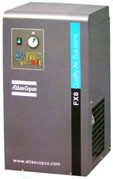 Environment friendly, quality dry air from FX Dryers for cost-efficient compressed air system
Environment friendly, quality dry air from FX Dryers for cost-efficient compressed air system
Poor air quality costs you money…..
If the corrosive sludge is allowed to enter the compressed air system, it will not be long before problems start to appear.Following are some of the most common and most expensive problems:
- Tools and equipment break down more regularly, experience a shorter lifetime and reduced power.
- The end product, or other materials that come into contact with the contaminated air, can suffer spoilage and quality degradation.
- The compressed air pipe work will corrode, leading to leaks and loss of valuable compressed air.
As an example, a small leak of just 3mm is roughly equivalent to wasting 3.7 kW of electricity. In a year, this would cost around Rs.1,25,000/- in wasted energy alone.
The simple solution for a costly problem
The FX range of refrigerant dryers offer a reliable, cost effective and simple solution.
To avoid condensation and therefore all chance of corrosion and damage, the compressed air needs to be dried, which is exactly what the FX units are designed to do.
These simple reliable units remove water from the air and the risk from your system, ensuring that your money doesn’t just disappear into thin air!!
Typical Example

Without a dryer 85 ltr. of water/day will enter into your air system on an average day. An Atlas Copco FX dryer removes virtually all the moisture before it reaches your air system.
Features
FX refrigerant dryers industrial performance – simple reliability
Air and refrigerant flow :
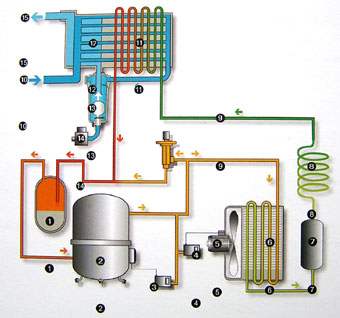
| Refrigerant Circuit | Air Circuit |
|---|---|
| Refrigerant Compressor Brings the gaseous refrigerant to a high pressure and a high temperature. | Air inlet Hot saturated air enters the dryer and is cooled by the outgoing air via the air-to-air heat exchanger. Reducing the temperature of the inlet air reduces the load on the refrigerant circuit(FX5 and above only) |
| Condenser Cools the refrigerant slightly so that it changes from gas to liquid as refrigerant is more effective in the liquid state. | Air outlet Re-heats the outgoing air to prevent condensation on the factory's pipe work(FX5 and above only) |
| Capillary filter Protects the expansion device from harmful particles. | Air-to-refrigerant heat exchanger Transfers heat from the compressed air to the cold refrigerant, forcing water vapour in the compressed air to condense. The more effective the heat transfer, the cooler the air becomes and the more water vapour condenses. |
| Capillary tube Reduces the refrigerant's pressure, thereby lowering its temperature and increasing its cooling capacity; the refrigerant is now almost all liquid, with some residual gas. | Water separator Collects and drains off condensate from the cooled air flow. The more efficient the separation, the better the pressure dew point, as droplets which are not collected revapourise and degrade the pressure dewpoint. |
| Hot gas bypass Regulates the amount of refrigerant passing through the air-to-refriegerant heat exchanger, ensuring a stable pressure dewpoint, and eliminating the chance of the condensate freezing. | Air-to-air heat exchanger All models include an air-to-air heat exchanger as standard, which prevents condensation forming on the outside of the pipe system. |
| Max. pressure switch (only for FX 13-15) It is a safety feature that allows to control the Refrigerant Compressor. | |
| FX control pressure switch (only for FX 13-15) It starts and stops the condenser fan Motor to maintain the condenser pressure as constant as possible. |
Specification
Technical data
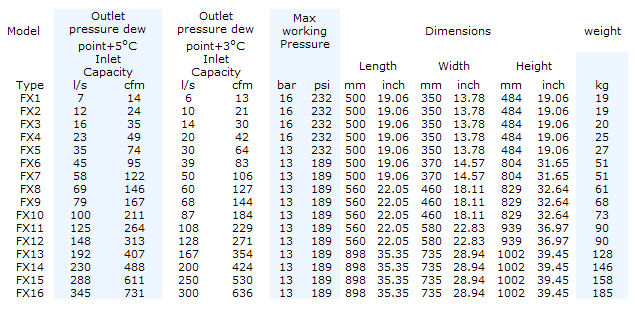
Benefits
FX refrigerant dryers – The benefits add up
- Solid Performance
- Steady pressure dew point
- No freezing of condensed moisture
- No chance of moisture entering the compressed air system
- Simple reliability
- Quality components, generously sized
- Simple and proven design
- Effective control system (hot gas bypass)
- Easy installation
- Plug and play concept
- Single electrical connection
- All units pre-commisioned
- Self regulating
- Minimal maintenance
- Long service intervals
- Few component replacements
- Ergonomic design for fast access to key components
- Significant cost saving
- Increased reliability and lifetime of tools and equipment
- Reduced pipe work leaks, meaning reduced energy bill
- Fewer repairs to tools, machines and pipework
- Less inconvenient breakdowns and stoppages
- Minimal chance of product spoilage through moisture carryover
- Environment friendly
- Compliant to strictest environment regulations
- CFC free refrigerants
Typical quality air installation proposal. How to select the right refrigerant dryer?
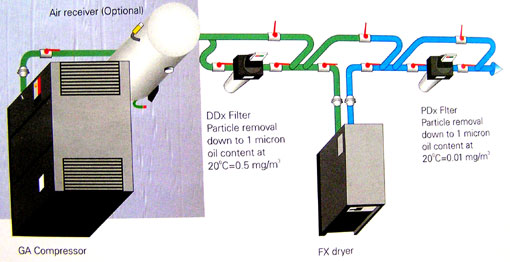
As a matter of fact, a pressure dew point lower than the ambient temperature will avoid condensation in the compressed air system. But this is not enough to prevent corrosion. Depending on the pipe material, corrosion may start if the relative humidity in the air net is above 50% Based on these facts, a relation between the ambient temperature and the pressure dew point required to avoid corrosion can be established.
The area below the dotted line represents a relative humidity lower than 50%, for example, for an ambient temperature of 25oC a pressure dew point of 13oC or lower is enough to prevent co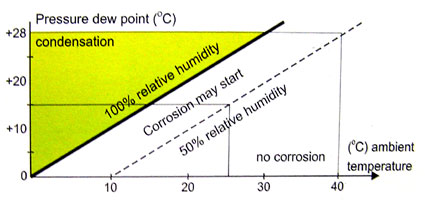 rrosion.
rrosion.
Correspondingly it is sufficient to maintain a pressure dew point below 28oC at an ambient temperature of 40oC to prevent air net corrosion.
As a thumb rule a dryer providing a pressure dew point 12oC below the ambient temperature will avoid water in the compressed air system and will protect the airnet against corrosion.
